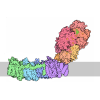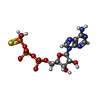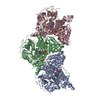[English] 日本語
 Yorodumi
Yorodumi- PDB-7vct: Human p97 single hexamer conformer III with D1-ATPgammaS and D2-A... -
+ Open data
Open data
- Basic information
Basic information
| Entry | Database: PDB / ID: 7vct | ||||||||||||
|---|---|---|---|---|---|---|---|---|---|---|---|---|---|
| Title | Human p97 single hexamer conformer III with D1-ATPgammaS and D2-ADP bound | ||||||||||||
 Components Components | Transitional endoplasmic reticulum ATPase | ||||||||||||
 Keywords Keywords | HYDROLASE / AAA+ ATPase / unfoldase / CELL CYCLE | ||||||||||||
| Function / homology |  Function and homology information Function and homology informationpositive regulation of Lys63-specific deubiquitinase activity / flavin adenine dinucleotide catabolic process / positive regulation of oxidative phosphorylation / VCP-NSFL1C complex / cytoplasm protein quality control / endosome to lysosome transport via multivesicular body sorting pathway / endoplasmic reticulum stress-induced pre-emptive quality control / cellular response to arsenite ion / Derlin-1 retrotranslocation complex / BAT3 complex binding ...positive regulation of Lys63-specific deubiquitinase activity / flavin adenine dinucleotide catabolic process / positive regulation of oxidative phosphorylation / VCP-NSFL1C complex / cytoplasm protein quality control / endosome to lysosome transport via multivesicular body sorting pathway / endoplasmic reticulum stress-induced pre-emptive quality control / cellular response to arsenite ion / Derlin-1 retrotranslocation complex / BAT3 complex binding / protein-DNA covalent cross-linking repair / positive regulation of protein K63-linked deubiquitination / deubiquitinase activator activity / mitotic spindle disassembly / VCP-NPL4-UFD1 AAA ATPase complex / ubiquitin-modified protein reader activity / regulation of protein localization to chromatin / aggresome assembly / NADH metabolic process / vesicle-fusing ATPase / cellular response to misfolded protein / stress granule disassembly / negative regulation of protein localization to chromatin / positive regulation of mitochondrial membrane potential / retrograde protein transport, ER to cytosol / K48-linked polyubiquitin modification-dependent protein binding / regulation of aerobic respiration / regulation of synapse organization / positive regulation of ATP biosynthetic process / ATPase complex / ubiquitin-specific protease binding / MHC class I protein binding / ubiquitin-like protein ligase binding / RHOH GTPase cycle / polyubiquitin modification-dependent protein binding / autophagosome maturation / HSF1 activation / negative regulation of hippo signaling / endoplasmic reticulum to Golgi vesicle-mediated transport / translesion synthesis / proteasomal protein catabolic process / Protein methylation / interstrand cross-link repair / ATP metabolic process / negative regulation of smoothened signaling pathway / endoplasmic reticulum unfolded protein response / ERAD pathway / Attachment and Entry / proteasome complex / viral genome replication / lipid droplet / Josephin domain DUBs / N-glycan trimming in the ER and Calnexin/Calreticulin cycle / macroautophagy / Hh mutants are degraded by ERAD / Hedgehog ligand biogenesis / Defective CFTR causes cystic fibrosis / positive regulation of protein-containing complex assembly / ADP binding / Translesion Synthesis by POLH / establishment of protein localization / ABC-family proteins mediated transport / : / autophagy / Aggrephagy / cytoplasmic stress granule / positive regulation of non-canonical NF-kappaB signal transduction / positive regulation of protein catabolic process / azurophil granule lumen / KEAP1-NFE2L2 pathway / positive regulation of canonical Wnt signaling pathway / Ovarian tumor domain proteases / double-strand break repair / positive regulation of proteasomal ubiquitin-dependent protein catabolic process / E3 ubiquitin ligases ubiquitinate target proteins / site of double-strand break / Neddylation / cellular response to heat / ubiquitin-dependent protein catabolic process / protein phosphatase binding / secretory granule lumen / regulation of apoptotic process / proteasome-mediated ubiquitin-dependent protein catabolic process / ficolin-1-rich granule lumen / Attachment and Entry / protein ubiquitination / protein domain specific binding / intracellular membrane-bounded organelle / DNA repair / lipid binding / DNA damage response / glutamatergic synapse / ubiquitin protein ligase binding / Neutrophil degranulation / endoplasmic reticulum membrane / perinuclear region of cytoplasm / endoplasmic reticulum / ATP hydrolysis activity / protein-containing complex / RNA binding Similarity search - Function | ||||||||||||
| Biological species |  Homo sapiens (human) Homo sapiens (human) | ||||||||||||
| Method | ELECTRON MICROSCOPY / single particle reconstruction / cryo EM / Resolution: 3.21 Å | ||||||||||||
 Authors Authors | Gao, H. / Li, F. / Shi, Z. / Li, Y. / Yu, H. | ||||||||||||
| Funding support |  United States, 3items United States, 3items
| ||||||||||||
 Citation Citation |  Journal: Cell Discov / Year: 2022 Journal: Cell Discov / Year: 2022Title: Cryo-EM structures of human p97 double hexamer capture potentiated ATPase-competent state. Authors: Haishan Gao / Faxiang Li / Zhejian Ji / Zhubing Shi / Yang Li / Hongtao Yu /   Abstract: The conserved ATPase p97 (Cdc48 in yeast) and adaptors mediate diverse cellular processes through unfolding polyubiquitinated proteins and extracting them from macromolecular assemblies and membranes ...The conserved ATPase p97 (Cdc48 in yeast) and adaptors mediate diverse cellular processes through unfolding polyubiquitinated proteins and extracting them from macromolecular assemblies and membranes for disaggregation and degradation. The tandem ATPase domains (D1 and D2) of the p97/Cdc48 hexamer form stacked rings. p97/Cdc48 can unfold substrates by threading them through the central pore. The pore loops critical for substrate unfolding are, however, not well-ordered in substrate-free p97/Cdc48 conformations. How p97/Cdc48 organizes its pore loops for substrate engagement is unclear. Here we show that p97/Cdc48 can form double hexamers (DH) connected through the D2 ring. Cryo-EM structures of p97 DH reveal an ATPase-competent conformation with ordered pore loops. The C-terminal extension (CTE) links neighboring D2s in each hexamer and expands the central pore of the D2 ring. Mutations of Cdc48 CTE abolish substrate unfolding. We propose that the p97/Cdc48 DH captures a potentiated state poised for substrate engagement. | ||||||||||||
| History |
|
- Structure visualization
Structure visualization
| Movie |
 Movie viewer Movie viewer |
|---|---|
| Structure viewer | Molecule:  Molmil Molmil Jmol/JSmol Jmol/JSmol |
- Downloads & links
Downloads & links
- Download
Download
| PDBx/mmCIF format |  7vct.cif.gz 7vct.cif.gz | 757.5 KB | Display |  PDBx/mmCIF format PDBx/mmCIF format |
|---|---|---|---|---|
| PDB format |  pdb7vct.ent.gz pdb7vct.ent.gz | 640.1 KB | Display |  PDB format PDB format |
| PDBx/mmJSON format |  7vct.json.gz 7vct.json.gz | Tree view |  PDBx/mmJSON format PDBx/mmJSON format | |
| Others |  Other downloads Other downloads |
-Validation report
| Summary document |  7vct_validation.pdf.gz 7vct_validation.pdf.gz | 1.6 MB | Display |  wwPDB validaton report wwPDB validaton report |
|---|---|---|---|---|
| Full document |  7vct_full_validation.pdf.gz 7vct_full_validation.pdf.gz | 1.6 MB | Display | |
| Data in XML |  7vct_validation.xml.gz 7vct_validation.xml.gz | 115.8 KB | Display | |
| Data in CIF |  7vct_validation.cif.gz 7vct_validation.cif.gz | 177.7 KB | Display | |
| Arichive directory |  https://data.pdbj.org/pub/pdb/validation_reports/vc/7vct https://data.pdbj.org/pub/pdb/validation_reports/vc/7vct ftp://data.pdbj.org/pub/pdb/validation_reports/vc/7vct ftp://data.pdbj.org/pub/pdb/validation_reports/vc/7vct | HTTPS FTP |
-Related structure data
| Related structure data |  31895MC  7vcsC  7vcuC  7vcvC  7vcxC M: map data used to model this data C: citing same article ( |
|---|---|
| Similar structure data |
- Links
Links
- Assembly
Assembly
| Deposited unit | 
|
|---|---|
| 1 |
|
- Components
Components
| #1: Protein | Mass: 90265.711 Da / Num. of mol.: 6 Source method: isolated from a genetically manipulated source Source: (gene. exp.)  Homo sapiens (human) / Gene: VCP / Production host: Homo sapiens (human) / Gene: VCP / Production host:  #2: Chemical | ChemComp-AGS / #3: Chemical | ChemComp-MG / #4: Chemical | ChemComp-ADP / Has ligand of interest | Y | |
|---|
-Experimental details
-Experiment
| Experiment | Method: ELECTRON MICROSCOPY |
|---|---|
| EM experiment | Aggregation state: PARTICLE / 3D reconstruction method: single particle reconstruction |
- Sample preparation
Sample preparation
| Component | Name: human p97 single hexamer conformer III with D1-ATPgammaS and D2-ADP bound Type: COMPLEX / Entity ID: #1 / Source: RECOMBINANT |
|---|---|
| Molecular weight | Value: 1.2 MDa / Experimental value: NO |
| Source (natural) | Organism:  Homo sapiens (human) Homo sapiens (human) |
| Source (recombinant) | Organism:  |
| Buffer solution | pH: 7.5 Details: 25 mM HEPES-NaOH pH 7.5, 100 mM NaCl, 5 mM MgCl2, 0.5 mM TCEP, 0.01% NP40 |
| Specimen | Conc.: 1 mg/ml / Embedding applied: NO / Shadowing applied: NO / Staining applied: NO / Vitrification applied: YES |
| Vitrification | Instrument: FEI VITROBOT MARK IV / Cryogen name: ETHANE / Humidity: 100 % / Chamber temperature: 277 K Details: 3ul sample was applied and the grids were blotted for 3.0 s under 100% humidity at 277K before being plunged into liquid ethane using a Mark IV Vitrobot (FEI). |
- Electron microscopy imaging
Electron microscopy imaging
| Experimental equipment |  Model: Titan Krios / Image courtesy: FEI Company |
|---|---|
| Microscopy | Model: FEI TITAN KRIOS |
| Electron gun | Electron source:  FIELD EMISSION GUN / Accelerating voltage: 300 kV / Illumination mode: FLOOD BEAM FIELD EMISSION GUN / Accelerating voltage: 300 kV / Illumination mode: FLOOD BEAM |
| Electron lens | Mode: BRIGHT FIELD / Cs: 2.7 mm / C2 aperture diameter: 100 µm / Alignment procedure: COMA FREE |
| Specimen holder | Cryogen: NITROGEN / Specimen holder model: FEI TITAN KRIOS AUTOGRID HOLDER |
| Image recording | Average exposure time: 0.3 sec. / Electron dose: 1.3 e/Å2 / Detector mode: COUNTING / Film or detector model: GATAN K2 SUMMIT (4k x 4k) |
- Processing
Processing
| Software | Name: PHENIX / Version: 1.13_2998: / Classification: refinement | ||||||||||||||||||||||||||||||
|---|---|---|---|---|---|---|---|---|---|---|---|---|---|---|---|---|---|---|---|---|---|---|---|---|---|---|---|---|---|---|---|
| EM software |
| ||||||||||||||||||||||||||||||
| CTF correction | Type: NONE | ||||||||||||||||||||||||||||||
| Symmetry | Point symmetry: C6 (6 fold cyclic) | ||||||||||||||||||||||||||||||
| 3D reconstruction | Resolution: 3.21 Å / Resolution method: FSC 0.143 CUT-OFF / Num. of particles: 65527 / Symmetry type: POINT | ||||||||||||||||||||||||||||||
| Atomic model building | Protocol: RIGID BODY FIT | ||||||||||||||||||||||||||||||
| Atomic model building | PDB-ID: 3CF3 Pdb chain-ID: A / Accession code: 3CF3 / Source name: PDB / Type: experimental model |
 Movie
Movie Controller
Controller






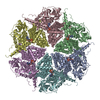

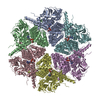
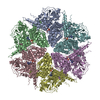
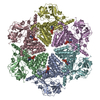



 PDBj
PDBj


